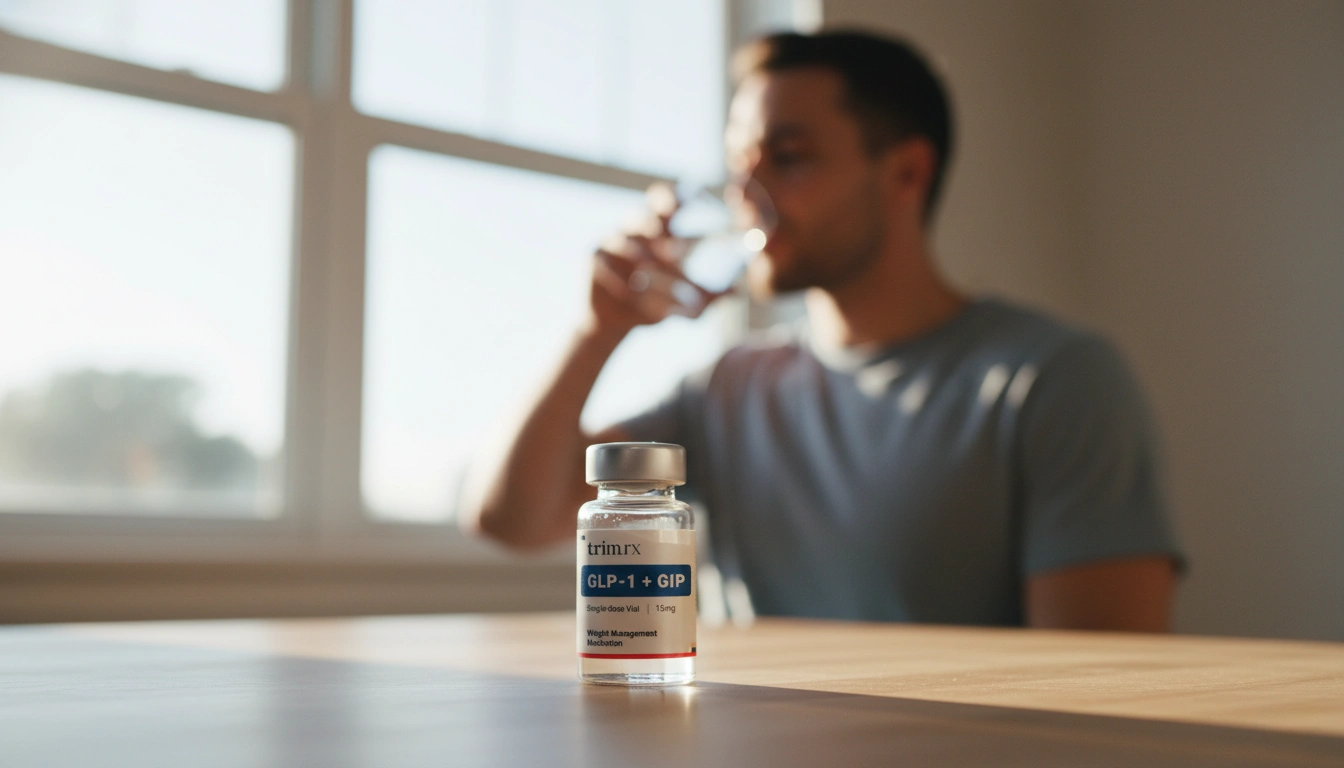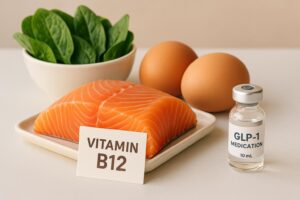Is There a Natural Form of GLP-1? Exploring Natural Ways to Boost This Essential Hormone

When it comes to weight management and metabolic health, glucagon-like peptide-1 (GLP-1) has recently garnered significant attention. In fact, GLP-1 has been labeled a “game changer” in the realms of both diabetes management and weight loss. But what exactly is GLP-1, and can we naturally increase its levels without resorting to pharmaceutical options? This blog post aims to explore the natural forms of GLP-1, the foods and lifestyle changes that can enhance its production, and how TrimRx integrates this knowledge into our personalized weight loss solutions.
Introduction
Did you know that our bodies already produce GLP-1 naturally? This hormone, secreted in the gut after we eat, plays a pivotal role in regulating blood sugar levels and appetite control. As the world grapples with rising obesity rates and associated health complications, understanding GLP-1’s function and ways to stimulate its production has never been more relevant.
At TrimRx, we believe that sustainable weight loss should be achieved through a holistic approach that encompasses diet, lifestyle changes, and personalized care. By the end of this article, we will provide you with a comprehensive understanding of GLP-1 and how to optimize its levels naturally. We will delve into various aspects, including the role of dietary fibers, proteins, and other lifestyle factors that influence GLP-1 secretion. Additionally, we will highlight the importance of our personalized weight loss programs that incorporate these insights into effective solutions for achieving lasting weight loss.
So, let’s embark on this journey together and uncover the natural ways to enhance GLP-1 levels in our body.
What is GLP-1?
GLP-1 is a hormone produced by the enteroendocrine cells in our intestines after we consume food. Its primary functions include:
-
Stimulating Insulin Secretion: GLP-1 enhances the release of insulin, a hormone responsible for lowering blood sugar levels by facilitating glucose uptake into cells.
-
Inhibiting Glucagon Release: GLP-1 reduces the secretion of glucagon, a hormone that raises blood sugar levels, thus providing a balance in glucose metabolism.
-
Slowing Gastric Emptying: By delaying the emptying of the stomach, GLP-1 helps maintain steady blood sugar levels and prolongs the sensation of fullness.
-
Promoting Satiety: GLP-1 signals to the brain that we are full, reducing overall calorie intake.
As a result of these functions, GLP-1 has become a focal point in the treatment of obesity and type 2 diabetes, with medications like semaglutide (Ozempic, Wegovy) and tirzepatide (Mounjaro) mimicking its effects. However, the question remains: can we boost GLP-1 naturally through our diet and lifestyle?
The Natural Forms of GLP-1: Can We Boost It Naturally?
While pharmaceutical interventions have proven effective, many individuals are curious about natural methods to enhance GLP-1 production. Research indicates that certain dietary choices and lifestyle modifications can significantly influence the secretion of this vital hormone.
1. Dietary Fibers and GLP-1
Dietary fibers play a crucial role in stimulating GLP-1 release. When we consume fiber-rich foods, they are fermented by gut bacteria, resulting in the production of short-chain fatty acids (SCFAs), which promote GLP-1 secretion. Here are some fiber sources that can help boost GLP-1:
-
Whole Grains: Foods like oats, barley, and brown rice are rich in soluble fibers that slow digestion and enhance satiety.
-
Fruits and Vegetables: High-fiber fruits such as apples, pears, and berries, along with vegetables like broccoli and Brussels sprouts, can significantly increase GLP-1 levels.
-
Legumes: Beans, lentils, and chickpeas are excellent sources of fiber and protein, both of which have been shown to stimulate GLP-1 release.
Incorporating these foods into your diet can create an environment conducive to GLP-1 production. By focusing on a plant-based diet rich in fiber, we can support our gut health and metabolic function.
2. Protein and GLP-1
Protein intake is another essential factor in promoting GLP-1 secretion. Consuming high-quality protein sources can stimulate the release of GLP-1 and enhance feelings of fullness. Some protein-rich foods to consider include:
-
Lean Meats: Chicken, turkey, and fish are excellent sources of protein that can aid in GLP-1 production.
-
Dairy Products: Greek yogurt and cottage cheese are not only high in protein but also contain beneficial probiotics that support gut health.
-
Plant-Based Proteins: Tofu, tempeh, and legumes are great options for those following a vegetarian or vegan diet.
Aim for a balanced intake of protein in each meal to maximize GLP-1 release and manage hunger effectively.
3. Healthy Fats and GLP-1
In addition to proteins and fibers, healthy fats can also play a role in GLP-1 secretion. Foods rich in monounsaturated and polyunsaturated fats can enhance GLP-1 levels, including:
-
Avocados: These nutrient-dense fruits are high in healthy fats and dietary fiber, making them an excellent choice for increasing GLP-1.
-
Nuts and Seeds: Almonds, walnuts, chia seeds, and flaxseeds provide a good source of fat and fiber, essential for GLP-1 production.
-
Olive Oil: Incorporating olive oil into your diet can provide healthy fats that support overall metabolic health.
By adding these healthy fats to our meals, we can create a more satisfying eating experience while also enhancing GLP-1 secretion.
4. The Role of Gut Health
Our gut microbiome plays a significant role in the production of GLP-1. A healthy gut flora can enhance the secretion of GLP-1, while dysbiosis (an imbalance in gut bacteria) can hinder it. Here are some ways to support gut health:
-
Probiotics: Incorporating probiotic-rich foods like yogurt, kefir, and fermented vegetables can help balance gut bacteria and support GLP-1 production.
-
Prebiotics: Foods rich in prebiotics, such as garlic, onions, and asparagus, provide nourishment for beneficial gut bacteria, promoting better gut health and enhancing GLP-1 secretion.
-
Avoiding Processed Foods: A diet high in processed foods can lead to an imbalance in gut bacteria. Prioritizing whole, minimally processed foods can support a healthy gut microbiome.
By focusing on gut health, we can create an environment that promotes GLP-1 production and supports overall well-being.
5. Regular Exercise and GLP-1
Physical activity is another crucial aspect of enhancing GLP-1 secretion. Regular exercise has been shown to improve insulin sensitivity and stimulate GLP-1 release. Here are some exercise recommendations:
-
Aerobic Exercise: Engaging in moderate-intensity aerobic activities such as walking, jogging, or cycling for at least 150 minutes per week can significantly boost GLP-1 levels.
-
Resistance Training: Incorporating strength training exercises at least two days a week can further enhance metabolic health and GLP-1 secretion.
-
High-Intensity Interval Training (HIIT): Short bursts of intense exercise followed by rest periods have been shown to improve insulin sensitivity and promote GLP-1 secretion.
By making physical activity a regular part of our lives, we can enhance GLP-1 levels and improve our metabolic health.
TrimRx’s Approach to Personalized Weight Loss
At TrimRx, our journey began with the vision of helping individuals embrace healthier lifestyles. We believe that sustainable weight loss should be achieved through science, empathy, and a transparent approach. Our personalized weight loss programs are designed to provide comprehensive support, including doctor consultations, medication, lab work, and unlimited support.
By integrating the insights from this article into our programs, we empower individuals to make informed choices about their health. Our platform offers a free assessment quiz to determine eligibility for our prescription weight loss medications, such as compounded Semaglutide and Tirzepatide, which are provided through FDA-registered pharmacies. You can take our quiz here.
Additionally, we offer quick-access supplements like our GLP-1 Daily Support and Weight Loss Boost to support your overall wellness during your weight loss journey.
Conclusion
In conclusion, GLP-1 is a vital hormone that plays a key role in regulating appetite and blood sugar levels. While pharmaceutical options have proven effective, there are numerous natural ways to enhance GLP-1 production through dietary choices and lifestyle modifications. By focusing on high-fiber foods, healthy fats, proteins, and maintaining gut health, we can encourage our bodies to produce more GLP-1.
At TrimRx, we are committed to providing personalized weight loss solutions that incorporate these insights into effective strategies for sustainable weight loss. Together, we can navigate the complexities of weight management and empower ourselves to lead healthier lives.
FAQ
What is GLP-1?
GLP-1 is a hormone produced in the gut that helps regulate blood sugar levels and appetite by stimulating insulin release and slowing gastric emptying.
How can I boost GLP-1 naturally?
You can increase GLP-1 levels by consuming fiber-rich foods, healthy fats, high-quality proteins, and maintaining a healthy gut through probiotics and prebiotics, as well as engaging in regular exercise.
Are there any supplements that can help increase GLP-1?
While some supplements claim to boost GLP-1 production, they may not have the same effect as natural dietary sources. It’s essential to consult with a healthcare provider before considering any supplements.
How does exercise affect GLP-1 levels?
Regular physical activity, including aerobic and resistance training, can enhance GLP-1 secretion and improve overall metabolic health.
How does TrimRx support weight loss?
TrimRx offers personalized weight loss programs that include doctor consultations, medication, lab work, and unlimited support, all designed to help individuals achieve sustainable weight loss. You can take our free assessment quiz to see if you qualify for our prescription weight loss medications.
By understanding the natural forms of GLP-1 and how to enhance its production, we can take proactive steps towards managing our weight and improving our overall health. Let’s embrace this knowledge and work towards a healthier future together.

Transforming Lives, One Step at a Time
Keep reading
Vitamin B12 and GLP-1 Medications: What to Know
GLP-1 medications can lower B12 absorption and intake; learn symptoms, food sources, supplement options, and how to monitor levels.
Semaglutide Injection Site Reactions: What To Know
Learn why semaglutide injections can cause redness, swelling or nodules, how to prevent and treat them, and when to seek medical care.
TrimRx vs Friday’s
Compare TrimRx and Friday’s telehealth GLP-1 weight-loss programs: pricing, medical support, coaching, delivery, and which fits your needs.



